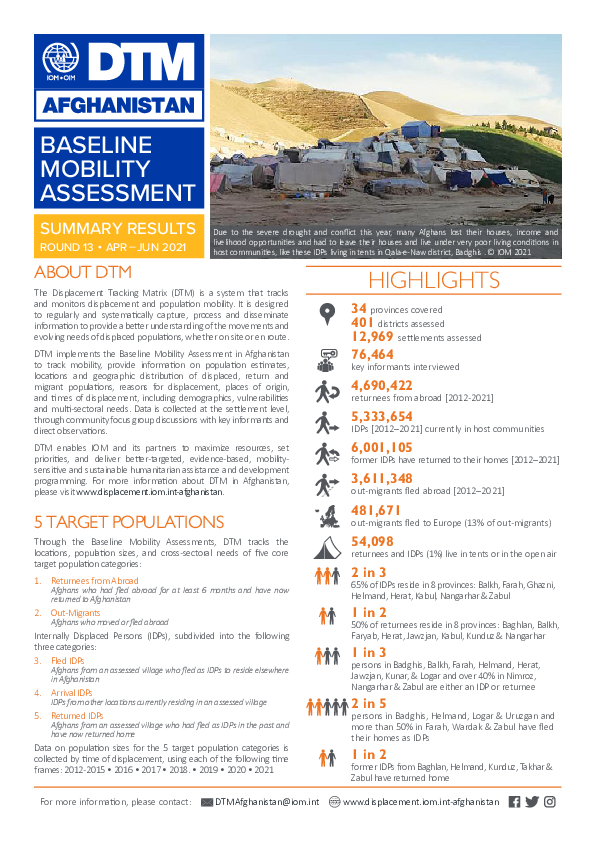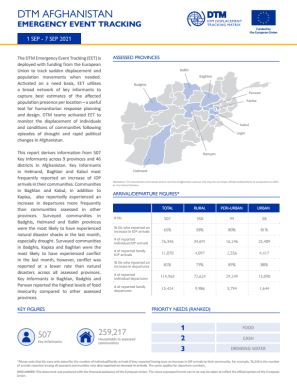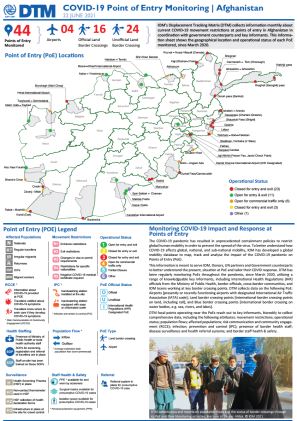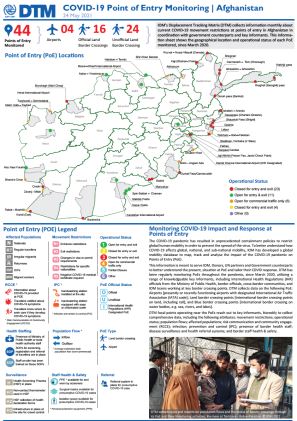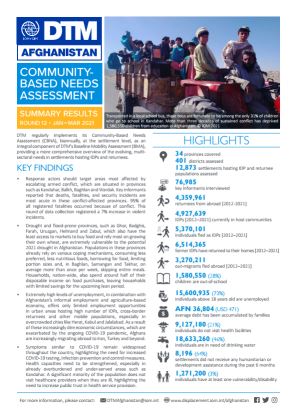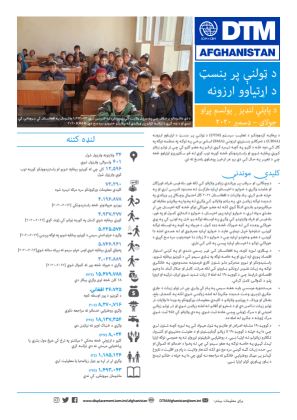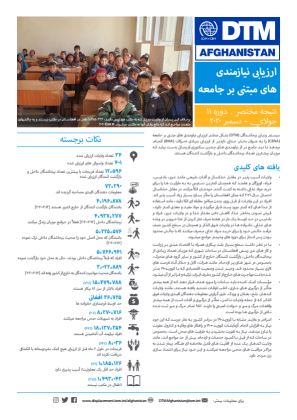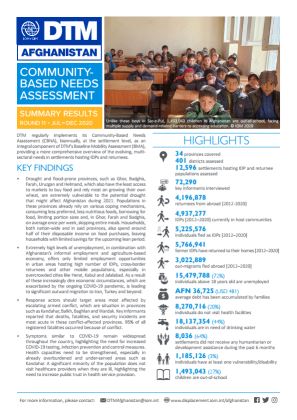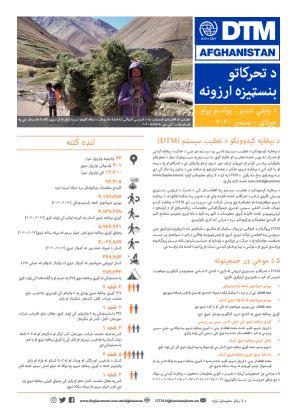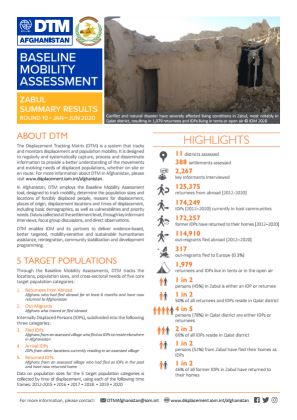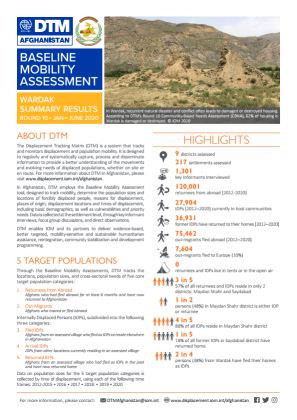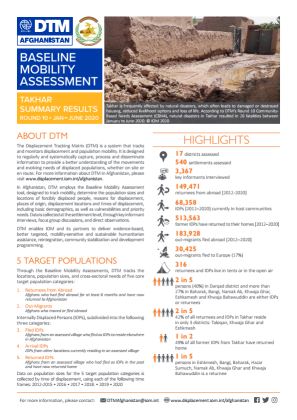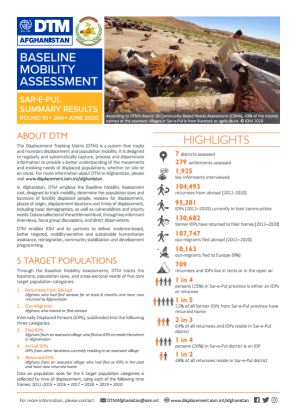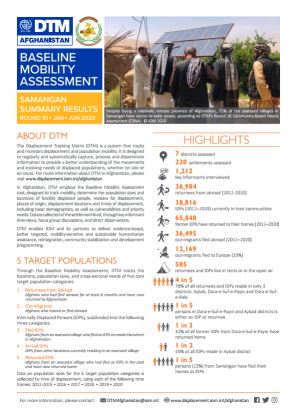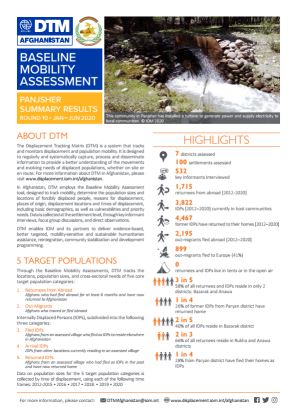-
Countries
-
Data and Analysis
-
Special Focus
-
Crisis Responses
Afghanistan
Afghanistan
Suivi des PDI
Mouvements de déplacement
4,187,000
IDMC 2023
cycle de collecte de données
À propos Afghanistan
The Displacement Tracking Matrix (DTM) is an information management system of tools and methodologies used to track and monitor displacement and population mobility. In Afghanistan, IOM activated the DTM programme in January 2017 in response to the substantial increase of Afghans returning home from neighbouring countries, as well as record levels of internal displacement. DTM in Afghanistan is designed to regularly and systematically capture, process and disseminate multi-layered information about the population sizes, locations, geographic distribution, movements, vulnerabilities, evolving multisectoral needs, and the drivers of migration of returnees, IDPs, migrants and mobile populations. DTM implements baseline mobility assessments, flow monitoring, registrations, and various migration surveys to provide an essential evidence base that enables decision-makers and humanitarian, reintegration and development partners to maximize resources and deliver efficient, better-targeted, mobility-sensitive and sustainable humanitarian; reintegration, community stabilization and development programming.
The value-added impact of DTM in Afghanistan is to inform action and results for people in need. DTM Afghanistan implements its activities at both the national and provincial levels. DTM works closely with other (IOM) programmes through referring identified populations in need of assistance at flow monitoring points to IOM’s Cross Border Return and Reintegration, Protection, Humanitarian Assistance, and Reintegration and Development (RADA) programmes. DTM Afghanistan also supports humanitarian partners and clusters, including WFP, FAO, UNHCR, IRC, DRC, NRC, and WHO, among many others, by providing emergency tracking updates in large-scale or sudden onset movements, such as emergency event tracking and drought response. Furthermore, stabilization and development actors, including IOM’s RADA programme, and the World Bank leverage DTM’s information to select priority communities and districts with higher concentrations of IDPs and returnees to receive reintegration and livelihoods assistance and improvements to core infrastructure and essential services. In support of health partners, including WHO, UNICEF, and the Humanitarian Health Cluster, DTM data informs the selection of priority, at-risk districts, border areas, communities, and health facilities in need of strengthened capacity, response, surveillance, and risk education for polio, TB, COVID-19, and other infectious diseases.
Contacter
Modher ALHAMADANI
Senior Programme Coordinator - DTM
malhamadani@iom.int
DTM AFGHANISTAN
DTMAFGHANISTAN@iom.int
Bailleurs de fonds
- Republic of Korea
- Norway
- CERF
- Canada
- Italy
- EU
- FCDO
Afghanistan — Emergency Event Tracking (1 - 12 September 2021)
The DTM Emergency Event Tracking (EET) tool is deployed with funding from the European Union to track sudden displacement and population movements.
CBNA R13 — Afghanistan — Community-Based Needs Assessment: Summary Results (April—June 2021)
In April through June 2021, DTM implemented the Community-Based Needs Assessment (CBNA) at the settlement level, as an integral component of DTM's Baseline Mobility Assessment (BMA), providing a comprehensive overview of the evolving, multi-sectoral needs in settlements hosting IDPs and returnees
Afghanistan — Baseline Mobility Assessment Summary Results (April—June 2021)
In Afghanistan, DTM employs the Baseline Mobility Assessment tool, designed to track mobility, determine the population sizes, locations and geographic distribution of forcibly displaced, return and migrant populations, reasons for displacement, places of origin, and times of
Afghanistan — Emergency Event Tracking (1 - 7 September 2021)
The DTM Emergency Event Tracking (EET) is deployed with funding from the European Union to track sudden displacement and population movements when needed.
Afghanistan — COVID-19 Impact on Points of Entry Report (27 July 2021)
The COVID-19 pandemic has resulted in unprecedented containment policies to restrict global human mobility in order to prevent the spread of the virus.
Afghanistan — COVID-19 Impact on Points of Entry Report (22 June 2021)
The COVID-19 pandemic has resulted in unprecedented containment policies to restrict global human mobility in order to prevent the spread of the virus.
Afghanistan — COVID-19 Impact on Points of Entry Report (24 May 2021)
The COVID-19 pandemic has resulted in unprecedented containment policies to restrict global human mobility in order to prevent the spread of the virus.
CBNA R12 — Afghanistan — Community-Based Needs Assessment: Summary Results (January—March 2021)
In January through March 2021, DTM implemented the Community-Based Needs Assessment (CBNA) at the settlement level, as an integral component of DTM's Baseline Mobility Assessment (BMA), providing a comprehensive overview of the evolving, multi-sectoral needs in settlements hosting IDPs and
Afghanistan — Baseline Mobility Assessment Summary Results (January—March 2021)
In Afghanistan, DTM employs the Baseline Mobility Assessment tool, designed to track mobility, determine the population sizes, locations and geographic distribution of forcibly displaced, return and migrant populations, reasons for displacement, places of origin, and times of
CBNA R11 — Afghanistan — Community-Based Needs Assessment: Summary Results (July—December 2020) [پښتو]
د بېځایه کېدوونکو د تعقیب سیسټم (DTM) د ټولنې پر بنسټ د اړتیاوو ارزونه (CBNA) د تحرکاتو بنسټیزې ارزونې (BMA) اساسي برخې په توګه د ۲۰۲۰ کال په ډسمبر میاشتې کې د کلیو په کچه ترسره کړه ترڅو په هغو کلیو کې چې تر ټولو زیاتو کورني بېځایه شویو او راستنېدونکو څخه کوربه توب کوي له څو سکټوریزو اړتی
CBNA R11 — Afghanistan — Community-Based Needs Assessment: Summary Results (July—December 2020) [دری]
سیستم ردیابی بیجاشدگان (DTM) در دسمبر سال ۲۰۲۰ ارزیابی نیازمندی های مبتنی بر جامعه (CBNA) را به عنوان بخش جدایی ناپذیر از ارزیابی بنیادی تحرکات (BMA) در سطح قریجات آنجام داد تا دید جامع تر از نیازمندی های چندین سکتوری قریجاتی بدست بیاید که میزبان بیشترین تعداد بیجاشدگان داخلی و بازگشت کنن
CBNA R11 — Afghanistan — Community-Based Needs Assessment: Summary Results (July—December 2020)
In January through December 2020, DTM implemented the Community-Based Needs Assessment (CBNA) at the settlement level, as an integral component of DTM's Baseline Mobility Assessment (BMA), providing a comprehensive overview of the evolving, multi-sectoral needs in settlements hosting IDPs a
BMA R11 — Afghanistan — Baseline Mobility Assessment Summary Results (July—December 2020) [پښتو]
د بېځایه کېدونکوو د تعقیب سیسټم په افغانستان کې د تحرک د ارزونې بنسټیزې وسیلې کاروي ترڅو له تحرکاتو څخه څارنه وشي او د نفوس په هکله اټکلونه، د جبري بېځایه کېدنو موقعیتونه او جغرافیه وي وېش څرګند شي.
BMA R11 — Afghanistan — Baseline Mobility Assessment Summary Results (July—December 2020)
In Afghanistan, DTM employs the Baseline Mobility Assessment tool, designed to track mobility, determine the population sizes, locations and geographic distribution of forcibly displaced, return and migrant populations, reasons for displacement, places of origin, and times of
BMA R10 — Afghanistan — Helmand Baseline Mobility Assessment Summary Results (January—June 2020)
In Afghanistan, DTM employs the Baseline Mobility Assessment tool, designed to track mobility, determine the population sizes, locations and geographic distribution of forcibly displaced, return and migrant populations, reasons for displacement, places of origin, and times of displacement, as wel
BMA R10 — Afghanistan — Zabul Baseline Mobility Assessment Summary Results (January—June 2020)
In Afghanistan, DTM employs the Baseline Mobility Assessment tool, designed to track mobility, determine the population sizes, locations and geographic distribution of forcibly displaced, return and migrant populations, reasons for displacement, places of origin, and times of displacement, as wel
BMA R10 — Afghanistan — Wardak Baseline Mobility Assessment Summary Results (January—June 2020)
In Afghanistan, DTM employs the Baseline Mobility Assessment tool, designed to track mobility, determine the population sizes, locations and geographic distribution of forcibly displaced, return and migrant populations, reasons for displacement, places of origin, and times of displacement, as wel
BMA R10 — Afghanistan — Uruzgan Baseline Mobility Assessment Summary Results (January—June 2020)
In Afghanistan, DTM employs the Baseline Mobility Assessment tool, designed to track mobility, determine the population sizes, locations and geographic distribution of forcibly displaced, return and migrant populations, reasons for displacement, places of origin, and times of displacement, as wel
BMA R10 — Afghanistan — Takhar Baseline Mobility Assessment Summary Results (January—June 2020)
In Afghanistan, DTM employs the Baseline Mobility Assessment tool, designed to track mobility, determine the population sizes, locations and geographic distribution of forcibly displaced, return and migrant populations, reasons for displacement, places of origin, and times of displacement, as wel
BMA R10 — Afghanistan — Sar-e-Pul Baseline Mobility Assessment Summary Results (January—June 2020)
In Afghanistan, DTM employs the Baseline Mobility Assessment tool, designed to track mobility, determine the population sizes, locations and geographic distribution of forcibly displaced, return and migrant populations, reasons for displacement, places of origin, and times of displacement, as wel
BMA R10 — Afghanistan — Samangan Baseline Mobility Assessment Summary Results (January—June 2020)
In Afghanistan, DTM employs the Baseline Mobility Assessment tool, designed to track mobility, determine the population sizes, locations and geographic distribution of forcibly displaced, return and migrant populations, reasons for displacement, places of origin, and times of displacement, as wel
BMA R10 — Afghanistan — Parwan Baseline Mobility Assessment Summary Results (January—June 2020)
In Afghanistan, DTM employs the Baseline Mobility Assessment tool, designed to track mobility, determine the population sizes, locations and geographic distribution of forcibly displaced, return and migrant populations, reasons for displacement, places of origin, and times of displacement, as wel
BMA R10 — Afghanistan — Panjsher Baseline Mobility Assessment Summary Results (January—June 2020)
In Afghanistan, DTM employs the Baseline Mobility Assessment tool, designed to track mobility, determine the population sizes, locations and geographic distribution of forcibly displaced, return and migrant populations, reasons for displacement, places of origin, and times of displacement, as wel
Pagination
Pagination
Pagination
- First page
- Previous page
- 1
- 2
- 3
- 4
- 5




